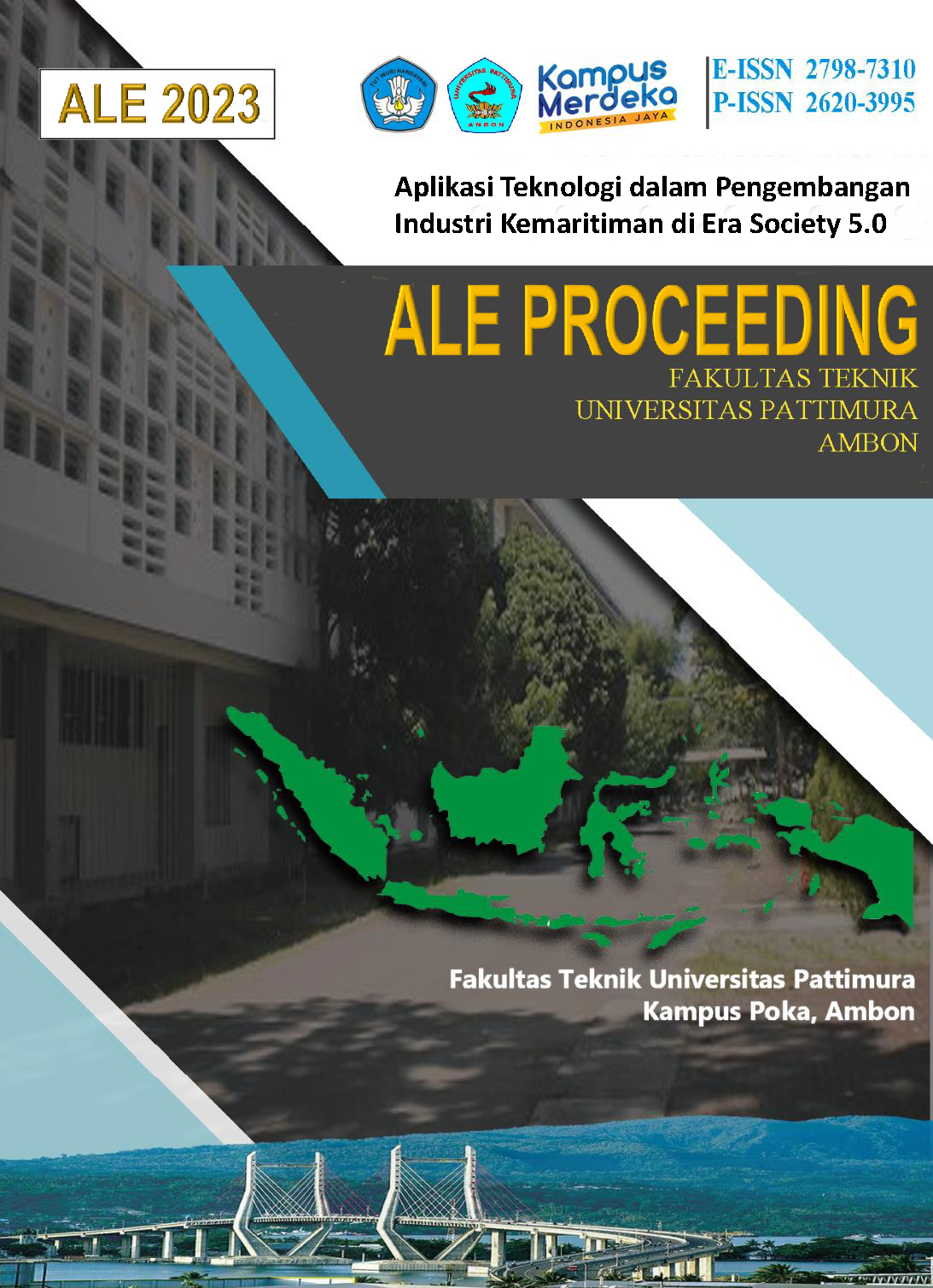PENILAIAN DAN MITIGASI RESIKO RANTAI PASOK DENGAN PENDEKATAN METODE HOUSE OF RISK
Abstract
Penelitian ini bertujuan untuk menilai dan memitigasi risiko pada aktivitas rantai pasok rumput laut yang ada di Desa Nuruwe Kabupaten Seram Bagian Barat (SBB). Metode yang digunakan dalam penelitian ini adalah pendekatan House of Risk (HOR) dengan mengidentifikasi setiap aktivitas proses bisnis rantai pasok berdasarkan model supply chain operation reference. Model HOR terdiri dari dua tahap yaitu HOR fase 1 untuk menjelaskan peringkat setiap penyebab risiko berdasarkan nilai Aggregate Risk Potential (ARP) dan HOR fase 2 untuk memberikan prioritas tindakan yang bersifat proaktif untuk mencegah risiko terjadi. HOR fase 1 menunjukkan lima penyebab resiko akan diprioritaskan untuk ditangani berdasarkan nilai ARP tertinggi, yang selanjutnya pada HOR fase 2 diusulkan delapan strategi mitigasi. Berdasarkan nilai Effectiveness to Difficulty (ETD), terpilih empat strategi mitigasi yang akan digunakan untuk mencegah penyebab risiko.
Downloads
References
Badan Pusat Statistik Provinsi Maluku, “Provinsi Maluku dalam angka,” 2021.
Dinas Kelautan dan Perikanan Provinsi Maluku, “Feasibility Study Rumput Laut di Kabupaten Seram Bagian Barat. Dinas Perikanan dan Kelautan Provinsi Maluku,” Ambon, 2006.
P. N. C. Iswarin, “Strategi Mitigasi Risiko Rantai Pasok Dengan Mempertimbangkan Kepentingan Multistakeholder: Studi Kasus Pada Industri Rumput Laut,” Institut Teknologi Sepuluh Nopember , Surabaya, 2018.
D. B. Paillin and T. Talib, “Alternatif Penanggulangan Tengkulak Dalam Usaha Budidaya Rumput Laut Di Kabupaten Seram Bagian Barat,” ARIKA, vol. 07, no. 1, 2013.
D. B. Paillin, J. M. Tupan, J. B. Paillin, V. O. Lawalata, and W. Latuny, “Priority Strategies Selection To Prevent Middlemen Domination In Shortening The Distribution Chain,” Acta Logistica, vol. 9, no. 3, pp. 279–290, Sep. 2022, doi: 10.22306/al.v9i3.309.
H. Mulyati and J. Geldermann, “Managing risks in the Indonesian seaweed supply chain,” Clean Technol Environ Policy, vol. 19, no. 1, pp. 175–189, Jan. 2017, doi: 10.1007/s10098-016-1219-7.
R. A. Hadiguna, Manajemen Rantai Pasok Agroindustri: Pendekatan Berkelanjutan untuk Pengukuran Kinerja dan Penilaian Risiko. 2016. doi: 10.25077/car.16.16.
D. Paillin, J. Tupan, J. Paillin, W. Latuny, and V. Lawalata, “Risk Assessment And Risk Mitigation In A Sustainable Tuna Supply Chain,” Acta logistica, vol. 9, no. 1, pp. 51–61, Mar. 2022, doi: 10.22306/al.v9i1.270.
D. B. Paillin and J. M. Tupan, “The supply chain risk assessment for tuna during the Covid-19 pandemic in Ambon by using the House of Risk Method,” in IOP Conference Series: Earth and Environmental Science, Ambon, 2021, pp. 1–11. doi: 10.1088/1755-1315/797/1/012024.
N. Perlekar and J. J. Thakkar, “Risk management framework for outsourcing in the defence sector: a case from India,” Int J Prod Res, vol. 57, no. 18, pp. 5892–5919, 2018, doi: 10.1080/00207543.2018.1555381.
R. Rathore, J. J. Thakkar, and J. K. Jha, “Evaluation of risks in foodgrains supply chain using failure mode effect analysis and fuzzy VIKOR,” International Journal of Quality and Reliability Management, vol. 38, no. 2, pp. 551–580, 2020, doi: 10.1108/IJQRM-02-2019-0070.
P. Zandi, M. Rahmani, M. Khanian, and A. Mosavi, “Agricultural risk management using fuzzy topsis analytical hierarchy process (Ahp) and failure mode and effects analysis (fmea),” Agriculture (Switzerland), vol. 10, no. 11, pp. 1–28, 2020, doi: 10.3390/agriculture10110504.
K. Govindan, R. Khodaverdi, and A. Jafarian, “A fuzzy multi criteria approach for measuring sustainability performance of a supplier based on triple bottom line approach,” J Clean Prod, vol. 47, pp. 345–354, 2013, doi: 10.1016/j.jclepro.2012.04.014.
I. N. Pujawan and L. H. Geraldin, “House of risk: A model for proactive supply chain risk management,” Business Process Management Journal, vol. 15, no. 6, pp. 953–967, 2009, doi: 10.1108/14637150911003801.
M. M. Mansor and N. H. Kamarulzaman, “Seaweed Supply Chain Risk Identification in Sabah Using Fuzzy Failure Mode and Effect Analysis,” in IOP Conference Series: Earth and Environmental Science, IOP Publishing Ltd, Sep. 2020. doi: 10.1088/1755-1315/549/1/012096.
G. Svensson, “A conceptual framework for the analysis of vulnerability in supply chains,” International Journal of Physical Distribution & Logistics Management, vol. 30, no. 9, pp. 731–750, 2000, doi: 10.1108/09600030010351444.
D. Waters, Suppy Chain Risk Management: Vulnerability and Resilience in Logistic. London: Kogan Page Publishers., 2011.
M. Goh, J. Y. S. Lim, and F. Meng, “A stochastic model for risk management in global supply chain networks,” Eur J Oper Res, vol. 182, no. 1, pp. 164–173, 2007, doi: 10.1016/j.ejor.2006.08.028.
C. S. Tang, “Perspectives in supply chain risk management,” Int J Prod Econ, vol. 103, no. 2, pp. 451–488, 2006, doi: 10.1016/j.ijpe.2005.12.006.
M. Christopher, H. Peck, C. Rutherford, and U. Jüttner, Understanding Supply Chain Risk : A Self- assessment Workbook. Department for Transport. Cranfield University, 2003.
W. A. Teniwut, K. D. Betaubun, M. Marimin, and T. Djatna, “Mitigasi Rantai Pasok Rumput Laut dengan Pendekatan House of Risk dan Fuzzy AHP di Kabupaten Maluku Tenggara,” agriTECH, vol. 40, no. 3, pp. 242–253, Dec. 2020, doi: 10.22146/agritech.27770.
H. Mulyati, “Supply Chain Risk Management Study of the Indonesian Seaweed Industry,” 2015.
Copyright (c) 2023 Willem Pelmelay, Daniel B. Paillin, Johan Marcus Tupan

This work is licensed under a Creative Commons Attribution-ShareAlike 4.0 International License.
An author who publishes in the ALE Proceeding agrees to the following terms:
- Author retains the copyright and grants ALE Proceeding the right of first publication of the work simultaneously licensed under the Creative Commons Attribution-ShareAlike 4.0 License that allows others to share the work with an acknowledgment of the work's authorship and initial publication in this journal.
- Author is able to enter into separate, additional contractual arrangements for the non-exclusive distribution of the journal's published version of the work (e.g., post it to an institutional repository or publish it in a book) with the acknowledgment of its initial publication in this journal.
- Author is permitted and encouraged to post his/her work online (e.g., in institutional repositories or on their website) prior to and during the submission process, as it can lead to productive exchanges, as well as earlier and greater citation of the published work (See The Effect of Open Access).
Read more about the Creative Commons Attribution-ShareAlike 4.0 Licence here: https://creativecommons.org/licenses/by-sa/4.0/.






